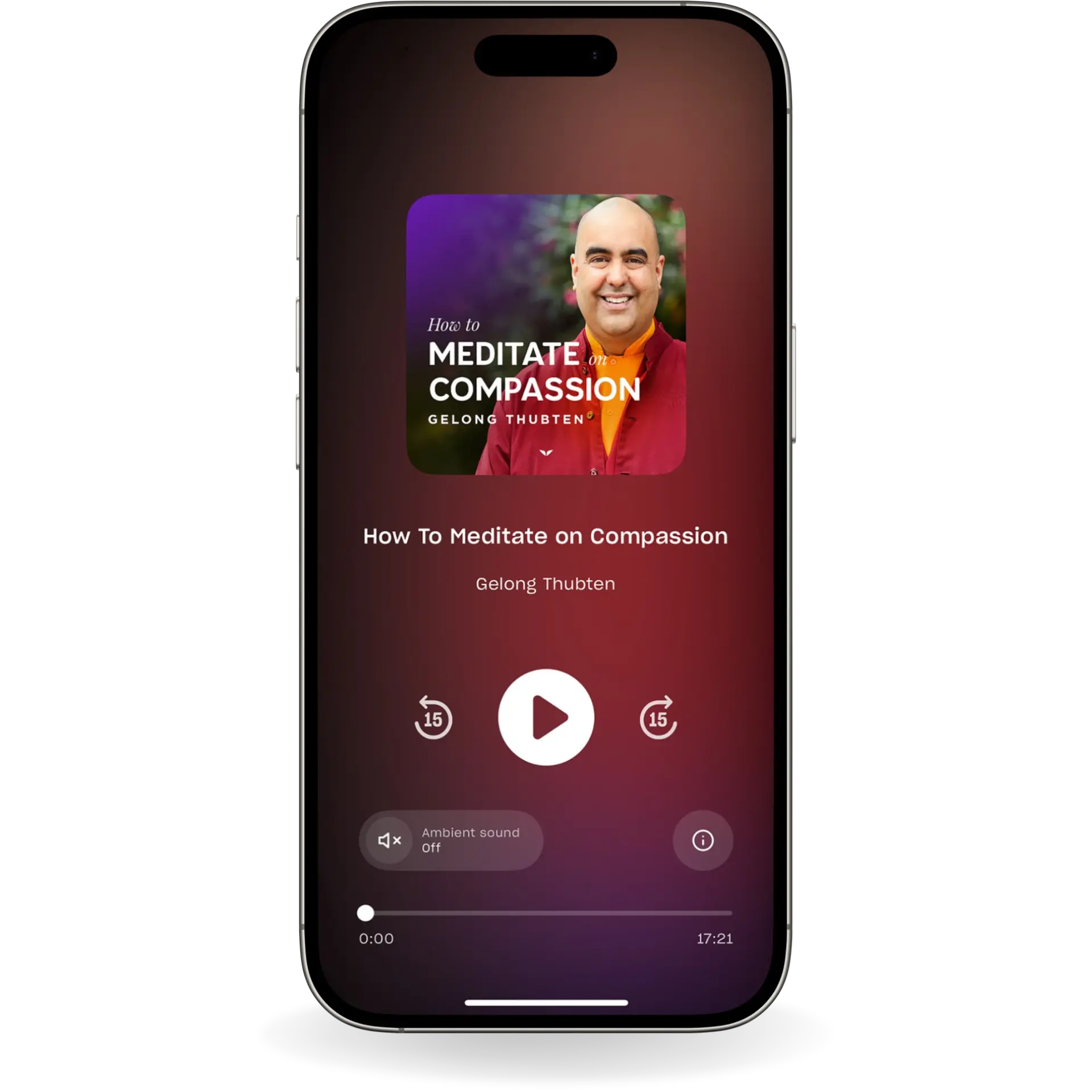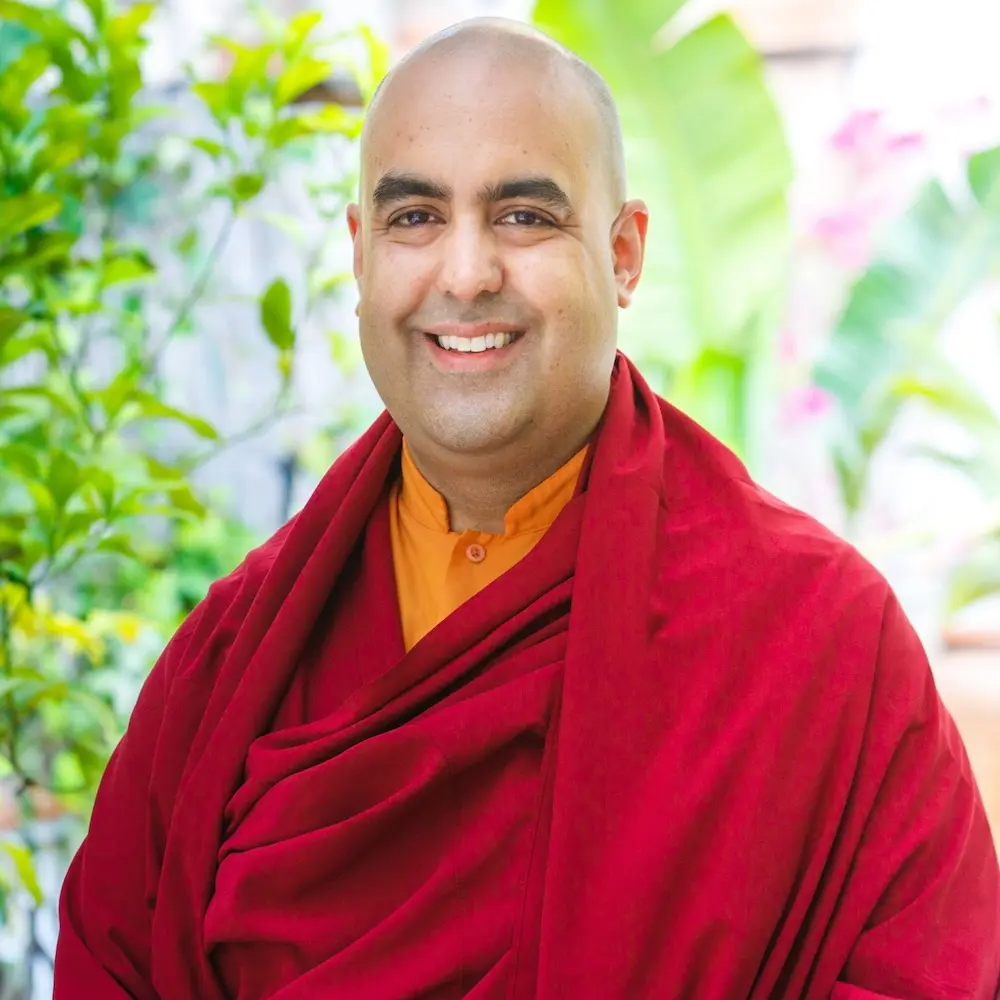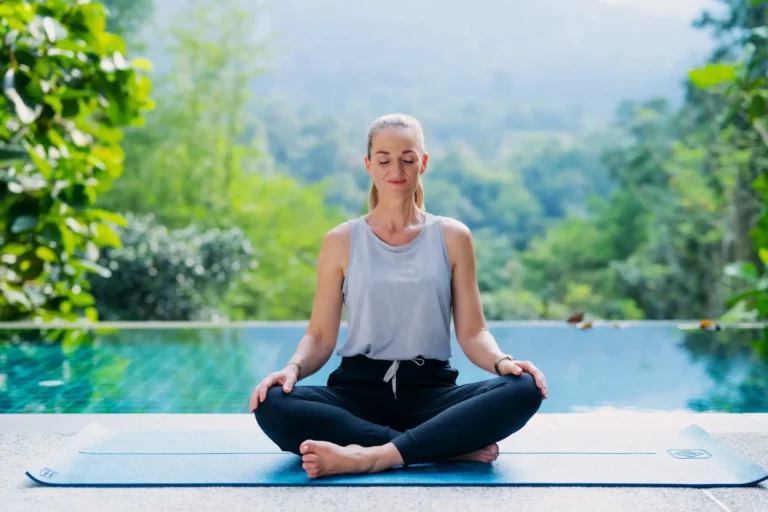His voice is calm and measured, just like someone who has spent years watching thoughts move without chasing them (which he did). There’s a gentleness to the pauses, which makes his wisdom, when shared, so lived in.
Before he ever taught mindfulness to Fortune 500 execs or spoke on stages packed with neuroscientists, renowned Buddhist monk Gelong Thubten was an actor trying to make it big.
For years, he chased applause from one casting call to another… until he burned out. But, as he’d share in his talks worldwide, it was the moment he also woke up.
As he shares in his Mindvalley program, Becoming More Loving, “Moments of tension are moments of opportunity.”
You hear this truth reverberate when he speaks and feel it in the way he sits. And if you’ve ever felt like life keeps pulling you down, then take a chance… and listen to him.
Who is Gelong Thubten?
Gelong Thubten is a renowned Tibetan Buddhist monk, mindfulness teacher, and Mindvalley trainer. With over two decades of monastic training, he teaches how to navigate modern life through meditation and the exploration of higher levels of consciousness. His work has reached Fortune 500 executives, medical professionals, and seekers worldwide.
Perhaps you looked up “Gelong Thubten’s A Monk’s Guide to Happiness” and found that he has that very book to his name, and then some. Or maybe “What is Gelong Thubten’s real name?” was what got you here. (P.S., it’s not listed publicly, thanks to monastic vows.)
What you won’t find online? This heartfelt story on his turning point to monkhood, which he shares with Mindvalley members attending his program:
“I was desperate to be happy… I started to meditate in quite a kind of addictive way… trying to get happiness. [But] the more I was sitting there searching for happiness in my meditation, the more depressed I became.”
And little did people know that this loneliness began long before Buddhism came knocking on his door.
His origin story
Long before the robes and retreats, Gelong was a Cambridge native trying to find his place in the world. After studying English literature at Oxford, he moved to New York to pursue a career in acting.
For a while, the flurry of auditions kept him busy. However, it didn’t take long before he started feeling crushed by endless rehearsals and set appearances.
Still, Gelong pressed on… until a chance encounter. He was deep in the industry when he crossed paths with Bernardo Bertolucci. The film director had just begun casting for Little Buddha, an East-meets-West film that would later star Keanu Reeves and introduce Buddhist philosophy to a global audience.
The reality was, Gelong didn’t land the part. But the story of Buddha’s life, captured by Bernardo’s script, stayed with him. So wrapped up in it he was that he decided to book a one-way ticket to Scotland’s Kagyu Samye Ling Monastery.
About this chapter of his life, he recalls, “I needed to do something incredibly radical to transform my life.”
How Gelong Thubten went from burnout to breakthrough
At the monastery, young Gelong began training under senior teachers and immersed himself in traditional Tibetan Buddhist study.
The routines and long hours, punctuated only by profound silence, were intense. Days are structured around prayer, work, and meditation. “I was getting frustrated and angry with myself and sad,” he shares.
However, eventually, after months of a strict, monastic regimen rooted in intuition training, everything became easier. This marked the beginning of his self-mastery. It was at this point that he realized he had been “completely driven by ego” all this while.
“The silence was uncomfortable at first,” he recalls. “Then it became familiar. Then it became home.”
At the same time his ego death happened, Gelong also realized that returning to New York was no longer the right thing to do. The monastic path, alas, was his new commitment. It showed him the ultimate goal of mastering his mind, including the subconscious vs. unconscious landscapes.
“The mind tries to pull you out,” he describes the process. But the point, he adds, is to keep training. “And that’s where real change begins.”
Over the next few years, his training continued to deepen. In 2005, he even entered a traditional four-year meditation retreat at the remote Isle of Arran off the coast of Scotland.
There, each day began before dawn and ended late at night. Nineteen hours of structured meditation, seven days a week. No phones, doomscrolling on the Internet, or contact with the outside world. During the second year, he took a five-month vow of silence.
This was the period that cemented his inner clarity and access to experiences of higher consciousness. “It’s a very powerful experience of having to face your own mind,” he says. “It’s very difficult but very rewarding.”
And the rest, as the adage goes, is history.
8 steps for mindful living, the Gelong Thubten way
Mindfulness, Gelong believes, is not at all about forcing your headspace to go blank. It’s about “learning to be with the thoughts, not push them away… and to bring a gentle attitude towards our minds.”
It’s a very powerful experience of having to face your own mind. It’s very difficult but very rewarding.
— Gelong Thubten, trainer of Mindvalley’s Becoming More Loving program
The goal with this? To build mental and emotional resilience and self-awareness. All of this is much needed in a time where up to 30% of adults in the U.S. are grappling with anxiety, and 27% feel trapped by the weight of chronic stress.
Here’s what this state of mind looks like in Gelong’s book:
- Start small. A few minutes a day of mindfulness meditation practices is enough. Don’t wait for the perfect moment. Begin where you are: right as you wake up, in transit to work, or while taking your evening walks.
- Use the breath as your anchor. Every inhale is a place to return to, especially when the mind wanders. Any mindful breathing technique will do.
- Don’t chase calmness. Mindfulness isn’t a “high,” but rather, the ability to stay put through any discomfort, boredom spell, or emotion. Practice it enough, and your nervous system will thank you.
- Practice in daily life. Waiting in line? Stuck in traffic? These are your everyday grounds for training your mind to return to the present moment.
- Let go of performance. Forget wearing the right clothes while trying out mindful yoga. You’re here to reconnect with your body… and yourself.
- Embody loving-kindness. In Buddhism, it’s what the Metta Sutta is all about. The moment we bring loving attention to something and choose warmth over judgment, Gelong says, “we’ve changed the whole inner environment.”
- Listen intently to others. Consider what your loved ones and strangers alike have to share with you. Wisdom is found in the unlikeliest of interactions.
- Be slow to anger. Anger clouds the mind and hijacks the moment. Awareness gives you space to choose clarity over reaction.
All it takes to be mindful is your commitment to stay on course, no matter what happens in your life. As Gelong succinctly puts it, “It’s all about training your mind to come back to the present moment again and again. That’s where the transformation happens.”
Gelong Thubten’s books
No matter where you are on your personal growth journey, Gelong’s books offer practical tools, lived insight, and grounded wisdom. Each one reads like a conversation with someone who’s been through the fire and stayed present:
- A Monk’s Guide to Happiness. This Sunday Times bestseller outlines how to work with discomfort rather than running from it. The guidance is clear, actionable, and rooted in experience. Meditation becomes a way to train the mind, rather than escape from it.
- Handbook for Hard Times. Written for anyone navigating a challenging season, this book distills the principles of building inner strength when life feels uncertain. Every page leans on what Gelong learned in silence, structure, and stillness.
- How to Be Human: The Manual. Written with comedian Ruby Wax and neuroscientist Ash Ranpura, this one blends science, mindfulness, and humor in a way that sticks. Gelong brings the meditative lens, helping readers understand their thoughts, reactions, and emotional patterns with clarity.
Each book offers a checkpoint beckoning you to keep looking within. Like Gelong describes in his program, “When we turn the mind inward, we’re meeting ourselves in a very honest and powerful way. That’s where healing begins.”
Transform and learn more with Gelong Thubten
Books are just one doorway. Gelong’s teachings live louder in the spaces where people need them most, whether it’s a guided meditation on the Mindvalley app or a talk on how to turn suffering into fuel.
So, if you want to learn from someone who’s walked the walk, these resources are definitely worth your time.
His course on Mindvalley
Embrace deep inner work when you sign up for Becoming More Loving, Gelong’s seven-day transformation program on the Mindvalley app.
Expect this mindfulness teacher to walk you through the pillars of compassion, forgiveness, and inner steadiness with equal parts compassion and radical honesty. You’ll learn how to train your mind to adapt with grace, let go with honesty, and love with presence.
P.S. The app also features the special Gelong Thubten guided meditation, How to Meditate on Compassion. It’s short and steady yet incredibly moving, inviting you to be aware of your posture, breath, body awareness, and heartfelt connection.

His famous words of wisdom
Looking for bite-sized wisdom to quickly ground yourself with when life spins out of control? These hand-picked Gelong Thubten quotes can help you cut through the noise and recenter:
- “Meditation is not about getting rid of thoughts. It’s about changing your relationship with them.”
- “We often try to change what’s outside. But the real shift begins when we turn the mind inward.”
- “Moments of tension are moments of opportunity.”
- “You don’t need to go to the mountaintop to find peace. It’s in the mind, and the mind is with you wherever you go.”
- “Real compassion includes ourselves. If we don’t give it to ourselves, we’re only borrowing it for others.”
- “When we learn to stay with discomfort, we discover the seeds of happiness hiding beneath.”
- “Forgiveness isn’t about saying what happened was okay. It’s about freeing yourself from the grip of the past.”
- “The mind is like a puppy. You have to keep bringing it back gently.”
- “Happiness is a skill. Train it.”
- “You are not your thoughts. You are the one who notices them.”
Save them. Return to them. Let them meet you right where you are.
His Mindvalley talks
These talks hit the core of Gelong’s message: emotional regulation skills can be developed by anyone, anytime. Whether you’re working through pain, disconnection, or the myth of future happiness, he’s there to hold your hand.
1. On forgiveness
Here, Gelong shares a Buddhist parable that reframes our understanding of anger.
Through this story, he demonstrates how we can stop blaming others and start recognizing pain as the true culprit. It’s a powerful shift that clears the path to real forgiveness, deepened resilience, and emotional clarity.
Watch the full talk below:
2. On gratitude
This talk explores the art of being thankful, even when life doesn’t go as planned. Discomfort, Geelong shares here, isn’t something to dodge, because it’s where genuine gratitude takes root.
The stories he shares here can inspire you to turn ordinary moments, such as traffic jams, into your best training ground for cultivating presence and peace.
Watch the full talk below:
3. On happiness
We’ve been sold the idea that happiness lives in the future. However, in this talk, Gelong completely flips that script. He breaks down why fulfillment doesn’t come from chasing peaks but from sitting with what’s here. It’s one of his most-streamed talks for a good reason.
Watch the full talk below:
How Gelong Thubten has transformed lives
Take it from Mindvalley students who have explored Gelong’s teaching and found themselves coming out more anchored, more open, and more capable of holding life as it is. The shift? It started quietly before changing everything.
Here’s what they have to say:
The photographer who found emotional release
Ana, a photographer from Gdansk, signed up for Becoming More Loving in hopes of moving through stored pain. What she found was gentleness, breath, and emotional release techniques that she could use time and time again.
“I truly loved every single breath while I was making the short meditation,” she shares. She’d recommend Gelong’s guidance for anyone wanting to forgive themselves and others but unsure where to start.
The physical therapist who bumped up his resilience
Fabian, a clinician from Phoenix, knew how to heal others but didn’t always have the tools to meet emotional friction with clarity. Through Gelong’s practices, he learned how to hold space for difficult people without losing center.
“This compassion,” he reflects, “will help me be more resilient to difficult people. Onward!”
The data analyst who softened his outlook
Orlando-based Dhanashree felt like the world around her was unstable. But with each day of the program, her lens on reality began to shift. A quiet sense of safety settled in.
“While studying this program, the world got lovelier and kinder,” she says, adding that she’s confident this outlook will stay on as she moves forward.
Awaken your spiritual superpower
If there’s anything that Gelong has shown us all, it’s that the present moment is not to be taken for granted but appreciated thoroughly. When we do, the need for performance stops, and the ability to show up authentically begins. Breath by breath, moment by moment.
And when you’re ready to stay in that space more often, Mindvalley’s free soul-searching resources are a solid place to start:
- The Manifestation Journal to help you name what matters to you, what keeps you mindfulness, and move along your true intentions.
- Soul-Searching Questions to get honest with yourself about what you want and why, and
- Free spiritual masterclasses from Gelong himself and other spiritual teachers like Deborah King, Jeffrey Allen, and Regan Hilllyer. Each one opens up a new dimension of your path back to presence.
Whether you’re just starting to meditate for the first time or looking to deepen your daily practice, Mindvalley is a place where ancient insight meets modern life… and where your healing can unfold without deadlines.
Just take it from Erin Tayles, a massage therapist from Kelowna whose life came to a complete stop after a string of personal and professional crashes. She thought she was finally stepping into her dream role, until burnout pulled the rug out.
Then, she discovered the power of personal transformation:
When I found Mindvalley, I had no idea the amazing impact it would have. The most positive part of moving along this journey is finding abundance in everything in life once again.
Just like her, you, too, can reclaim that kind of inner peace. These tools are just the beginning. And when you’re ready for the next step, Mindvalley’s here to walk beside you.
Welcome in.








